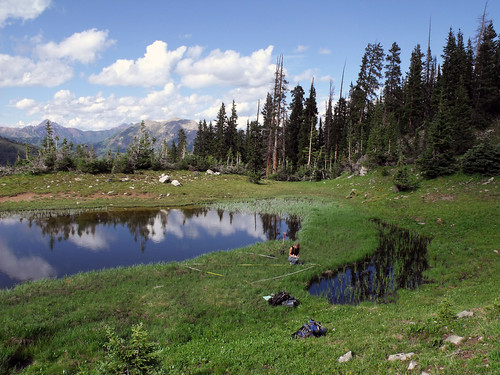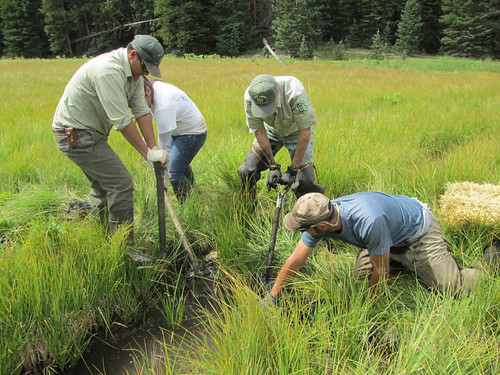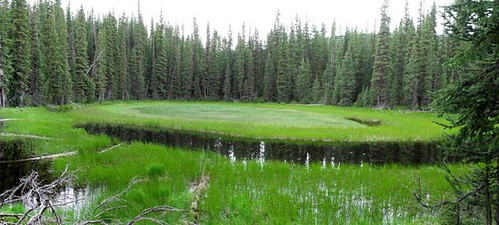
Sloshing through a wet meadow in ankle deep water, I am surrounded by thick mats of sedges, rushes and some beautiful wildflowers. This saturated meadow lies in the shadows of the 13,000-foot Sheep Mountain peak near Trout Lake, Colorado. It is a scenic spot, rich in plant diversity, but also a unique habitat in Colorado.
I am visiting this lush, high-altitude wetland with the Grand Mesa Uncompahgre and Gunnison National Forests’ lead hydrologist, Gary Shellhorn who explains that this wet meadow is called a fen. Fens are peat-forming wetlands, created when wetland plants die leaving mats of dead and decaying plant matter. Fens are sustained by mineral-enriched groundwater, which is less acidic. For this reason fens support a more diverse plant and animal community. In southern Colorado, it takes about 2,000 years to accumulate eight inches of peat at a fen. This suggests that most fens are 4,000 to 10,000 years old.
Fens are mostly a northern hemisphere phenomenon, occurring in the northeastern United States, the Great Lakes region, the Rocky Mountains, and much of Canada – and are generally associated with low temperatures and short growing seasons where excessive moisture accumulates from rain or snow.
Ben Stratton, a hydrologist with the national forests, was part of a team of specialists that inventoried the forest for the occurrence and condition of fens. The team searched for fens across the three-million acre forest. It was estimated that about 1,700 fens covering 11,000 acres may occur on these national forests.
“About 90 percent of the fens found are between 9,000 and 12,000 feet in elevation, and most fens are geologically associated with glacial drift or mass wasting,” Stratton said.

In the late 1800s and early 1900s, many peat lands were flooded by reservoir construction or drained for farming and other land uses. Of the nearly 150 fens surveyed, six fens had no apparent disturbances. The majority had been disturbed by flooding, de-watering, grazing, off highway vehicle tracks, roads, and even campsites.
Last summer, the forests’ hydrologists experimented with a couple of creative “fen restoration” projects. The surface flows to one fen had been channelized, partially drying up the area. By installing straw bales in channelized sections, the flows spread across the fen to inundate about 13 acres of the previously dewatered wetland.
“Our goal is to understand how to restore the function of impaired fens that took thousands of years to form” Shellhorn said.
Fens, like all wetlands, provide important benefits in a watershed. By slowing runoff, fens helps reduce flooding; the vegetation filters pollutants, improving water quality; and lush wetlands provide habitat for unique plants and animals.
“Through the fen restoration efforts, our successes will improve the condition of our watersheds, which will ultimately benefit the water quality and quantity for the public,” Shellhorn said.
Read more about the work to restore and preserve fens in west-central Colorado.

